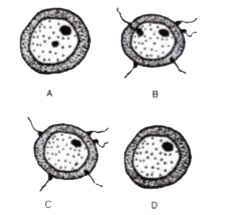The change undergone by the sperm to make it competent for fertilization in the female reproductive tract is called
circumcision
capacitation
castration
cryptorchidism
Step-by-Step Solution:
1. Understanding the Question: The question asks about the specific change that sperm undergoes to become competent for fertilization within the female reproductive tract.
2. Analyzing the Options: The options provided include circumcision, capacitation, castration, and cryptorchidism. We need to evaluate which of these terms relates specifically to the maturation of sperm for fertilization.
3. Evaluating Circumcision: Circumcision is a surgical procedure involving the removal of the foreskin from the penis. It is not related to sperm maturation or fertilization. Therefore, this option can be eliminated.
4. Identifying Capacitation: Capacitation is a process that sperm undergoes after ejaculation when they enter the female reproductive tract. This process is crucial for sperm to gain the ability to fertilize an egg. It involves biochemical changes that enhance sperm motility and prepare them for the acrosome reaction.
5. Understanding the Biochemical Changes: During capacitation, several changes occur at the cellular level, including an increase in intracellular pH (alkalization) and changes in the sperm's membrane, which are essential for the sperm to penetrate the egg.
6. Evaluating Castration and Cryptorchidism: Castration refers to the surgical removal of the testis, which does not relate to sperm maturation. Cryptorchidism is a condition where the testis fails to descend into the scrotum, also unrelated to the capacitation process.
7. Conclusion: After evaluating all the options, the correct answer is capacitation, as it specifically refers to the changes that sperm undergo to become competent for fertilization in the female reproductive tract.
Final Answer: The change undergone by the sperm to make it competent for fertilization in the female reproductive tract is called capacitation.
---
Topper's Solved these Questions
- TEST 1BOOK - AAKASH INSTITUTE ENGLISHCHAPTER - TEST 1EXERCISE - Examplle
19 Videos
- STRUCTURAL ORGANISATION IN ANIMALS (CONTD . . .) (ANIMAL MORPHOLOGY)BOOK - AAKASH INSTITUTE ENGLISHCHAPTER - STRUCTURAL ORGANISATION IN ANIMALS (CONTD . . .) (ANIMAL MORPHOLOGY)EXERCISE - Assignment (Section-D)
10 Videos
- TEST 2BOOK - AAKASH INSTITUTE ENGLISHCHAPTER - TEST 2EXERCISE - EXERCISE
619 Videos
Similar Questions
Knowledge Check
Passage of ova through female reproductive tract is facilitated by
Aciliary movementBamoeboid movementCflagellar movementDcyclosis.A sex gland which contributes fluid containing sugar fructose that provides spermatozoa energy for swimming and hormone prostaglandins that stimulate contractions in the female reproductive tract to aid sperm-ovum interaction is
ACowper's glandBprostate glandCseminal vesicleDpreputial gland.Assertion : In barrier methods, ovum and sperms are prevented from physical meetings
Reason : Barrier methods are used during coitus, to prevent the entry of ejaculated semen into the female reproductive tract.AIf both assertion and reason are true and reason is the correct explanation of assertionBIf both assertion and reason are true but reason is not the correct explanation of assertionCIf assertion is true but reason is falseDIf both assertion and reason are false
The percentage of sperms that exhibit vigorous motility after ejaculation into female reproductive tract
View SolutionFlowers having both male and female reproductive parts are called
View SolutionGiven below are diagrams showing the different stages in the process of fertilisation of an egg in the human female reproductive tract.
Study the diagrams and answer the questions

(i) Arrange the letters given below each diagram in a logical sequence to show the correct order in the process of fertilisation.
(ii) Where does fertilisation normally take place? What is 'Implantation' that follows fertilisation ?
(iii) Mention the chromosome number of the egg and zygote in humans.
(iv) Explain the term 'Gestation'. How long does Gestation last in humans ?
(v) Draw a neat, labelled diagram of a mature human sperm.
View SolutionWhat is the significance of ampullary-isthmic junction in the female reproductive tract?
View SolutionThe method of directly injecting a sperm into ovum in assisted reproductive technology is called
View Solution
